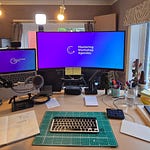Welcome back to the Facilitation Studio. This is the second and final article in the "Art of the Presentation" mini-series. Last issue, we talked about the following:
Why you should present your own work
Knowing your audience
Giving an engaging performance
We'll use this issue to cover a range of other key aspects of your presentation.
Before diving in, The Facilitation Studio will open its first online course in the next few weeks.
As a group of people what I’d like to benefit from this course, I’d love your insight into what I’ll be covering. Please take three minutes to fill out this survey. It will help me make sure I’m hitting the right learning outcomes.
Ok, with that plea out the way… let's get started!
The Effective Use of Slides

In today's business world, imagining a presentation without slides is almost impossible. But slides are just tools to reinforce your message and aren't the main focus of your presentation (that's you!).
Use Them to Elevate Your Point: Use slides sparingly and only to highlight key points. Sometimes, you don't need a slide. Imagine you're paying to print that slide out. Is it really worth a cut of your budget?
Keep Slides Simple and Concise: Avoid cluttering your slides with too much information. Your audience will try to read any words on the slide you show or interpret a diagram that pops up. While doing that, they aren't listening to you, so use what is necessary to support your points and nothing more.
Remember, Presentable and Sharable Documents Are Different: A shareable document should contain all the detailed information and context, while your presentation slides should be concise and support your verbal delivery. You can create your sharable first, then cut 80% of the content to make your presentation outline.
Guidelines for your preparation and presentation
There are various structures for presentations, and you don't need to reinvent the wheel. Here are a few guidelines and structures you might want to consider:
15 Minutes of Prep for every minute of Presentation: This ratio works well if you know your subject well. However, for unfamiliar topics, you'll need more preparation time.
Don't talk for more than 20 minutes: Your audience will lose focus (realistically, that starts to drop off after ten minutes) and won't absorb all your points. If you can't fit what you want to communicate in 20 minutes, you should refine your message to what you need to communicate. You can add colour in future or through Q&A.
10 Slides for 20 Minutes: A good rule of thumb is to use 10 slides for a 20-minute presentation at most. This keeps the pace manageable and forces you to consider the points you want each slide to support.
Pecha Kucha: 20 slides, 20 seconds a slide. Give up control and trust your timing as you run through your presentation in 6 mins and 20 seconds. This is fun, but intense. It’ll really force you to cut to the key information and practice your presentation delivery.
Share Each Slide for at Least 30 Seconds: Conversly to pecha kucha, you might want to ensure each slide remains on screen long enough for the audience to digest the information and return to you. As with facilitation and design, presenting is an art; in art, we break the rules for impact. Sometimes, flashing up a slide for just a few seconds is a great way to hammer your point home.
Practice Makes Perfect
The secret to an excellent presentation lies in practice. I'm afraid there is no magic pill. So take every opportunity you can to practice. Here are some tips:
Present every run-through: Every time you review your notes, present as if you were in the actual meeting. Use your extrovert voice and practice that projection and engagement. This will help you get to know your material; you'll experiment with different ways of expressing each point and settle on the way that feels most natural.
Record Yourself: Although it can be uncomfortable, watching yourself helps identify areas for improvement and reinforces what worked well. It also lets you control the content shared in virtual presentations, as you can share a "clean" copy rather than a recorded Zoom meeting.
Watch the Recording: Although it can be uncomfortable, watching yourself helps identify areas for improvement and reinforces what worked well.
Don’t hold yourself to TED talk standards
While aspiring to give a TED talk-level presentation is great, remember that these speakers are given about six months of expert coaching to give that one presentation. Be kind to yourself, and remember what you're setting out to achieve. Measure your success against that objective. Aim to be engaging and clear; your audience will appreciate your effort.
Telling Your Audience Why They Should Care
Finally, and most importantly, tell your audience why they should care about your presentation. Do it before they arrive, do it when you start, and do it again as you finish. This involves:
Don't give them too much to care about: Identify the relevant key messages to your specific audience. Focus on just two or three main points.
Encourage Action: Presentations should drive action. Clearly communicate what you want your audience to do after your presentation.
Wrapping up
Good design and ideas can't speak for themselves; they need a voice. Your role is to be that voice and ensure your audience understands and values your presentation.
Go out onto that stage and take up the space you deserve to own. You've got this.
I hope these issues have helped you feel more confident and effective in your presentations.
Until next time, Happy Facilitating.






